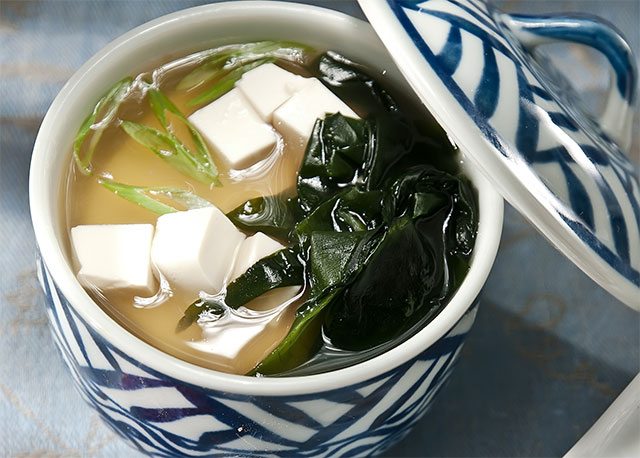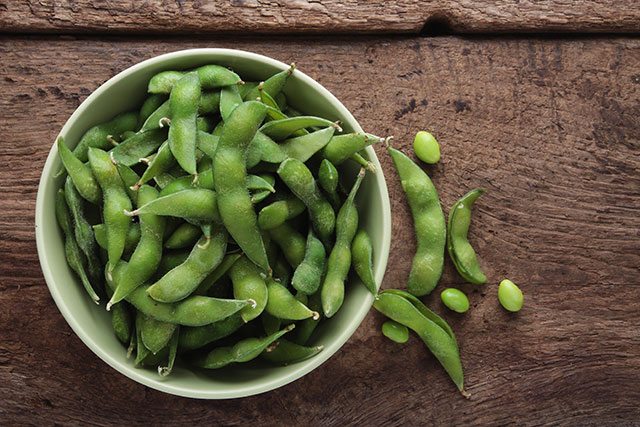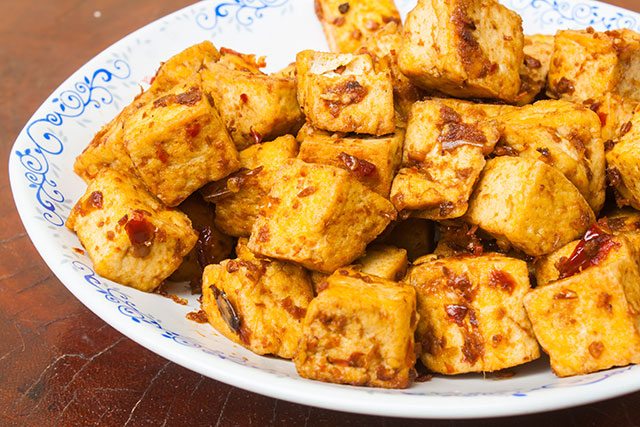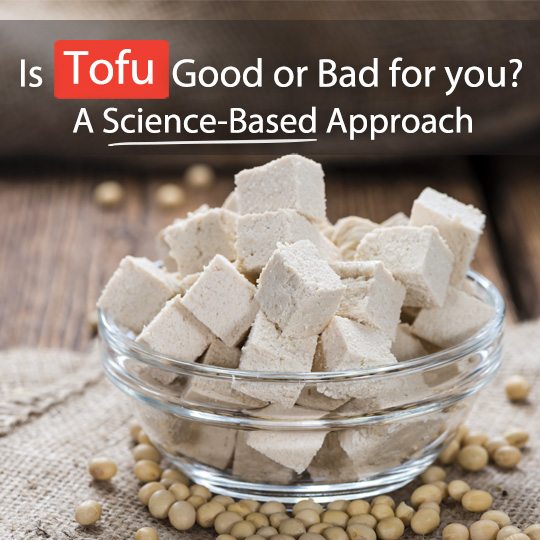“Stay away from soy, and soy-based products such as tofu. They cause many health problems and can even KILL YOU!”
Sound familiar? That’s because this type of alarmist message is widespread. All you need to do is type tofu + health in any search engine and you’ll be bombarded with articles touting the harm of tofu and the health dangers of soy. But is tofu really as bad for you as these articles make it seem? Read on to find out.
[hr]
You’ll recognize the alarmist type of message I’m talking about in any of the following claims:
- Tofu is an unhealthy processed food.
- Soy-based products block the absorption of minerals and injures your insides.
- Soy-based products messes with your thyroid function and slows down your metabolism.
- Tofu will give you breast cancer.
- Soy-based products makes men less manly.
- Soy-based infant formula is dangerous to babies.
That’s enough to scare anyone into never wanting to get close to a block of tofu again!
When a close friend, worried about giving her toddler soy-based products, shared yet another alarmist article of the sort, I figured it might be time to actually take a closer look at the available scientific data regarding tofu and share my findings with her, and, by the same token, you!

A couple of years back, the Agency for HealthCare Research And Quality produced a large (100-page) report in which they soundly reviewed the relevant human data on soy. I’ve included the link to this report here, for those of you interested in taking a closer look at this unbiased, scientific review.
For those of you not interested in an extensive summary of the literature, let me cut to the chase and share with you this report’s conclusion, based on the review of thousands of studies based on rigorous criteria and scientific validity:
There is no conclusive evidence of an effect (either negative or positive) of soy protein or isoflavone based on the evidence that exists today.
In other words, the negative effects of soy are largely overstated!
So what are all these studies and unscientific articles floating around the worldwide web basing their arguments on?
Well, for one, many cite no sources, so it’s hard to tell… A good point to be kept in mind whenever reading a health post (alarmist or not), is to give more value to those who do cite scientific references.
But what about those who do include such citations, supporting pretty gnarly negative effects of consuming soy and soy-based products like tofu?
As for those who do include citations, supporting pretty gnarly negative effects of soy and soy-based products such as tofu, there’s no denying they exist. Yet, an often overlooked fact is that the amount of soy used in many of these studies is much higher than what an average person would normally consume. I’m talking about doses equivalent to as much as one pound of tofu per day! Not many people I know consume that much tofu, consistently, every day…
What’s more, many studies are performed on mice and rats, which, cute as they may be, are quite different from humans. This means that extrapolation of findings from animal studies to humans must be done with particular caution.
That being said, let’s take a closer look at some of those alarmist claims!

Tofu Is High In Toxins, Injures Your Insides And Causes Chronic Deficiencies
Soybeans are an excellent source of iron, calcium, manganese and selenium as well as a good source of magnesium, copper and zinc. Yet, an often-heard anti-tofu argument is that the soybeans used to make tofu also contain a large quantity of toxins and anti-nutrients which can cause a variety of gastric problems and nutrient deficiencies.
So, is this true? After some digging, here’s what I found:
Soy does contain three main “anti-nutrients”; trypsin-inhibitors, phytates and lectins.
- Trypsin is an enzyme needed to properly digest protein which means that trypsin inhibitors in soy can reduce protein digestion in the stomach and small intestine.
- Phytates are naturally present in all grains, seeds, nuts and legumes and are compounds which tie up minerals such as calcium, zinc and iron, decreasing their absorption from the intestine.
- Finally, lectins are a protein also found in grains, seeds, nuts and legumes that that can cause adverse effects ranging from nausea to bloating if consumed uncooked or improperly cooked or in excess.
Eating raw soybeans involves getting a side of these three compounds. Soaking and cooking the soybeans tends to deactivate some of the trypsin inhibitors and eliminate a good amount of the phytates and lectin content.
Sprouting soybean prior to producing tofu can also decrease levels of trypsin inhibitors and phytates by up to 81% and 56% respectively, in addition to increasing protein content by up to 13%.
Fermentation also does the trick, which is why you may want to reach for products such as miso, tempeh, natto or tamari (a naturally fermented soy sauce) more often. Natto may be especially healthy as it contains a significant amount of vitamin K2, important for cardiovascular and bone health.
[color-box color=”main”]The Verdict: Soybeans do contain some “anti-nutrients,” but, in the grand scheme of things, they’re unlikely to pose a real threat to your nutritional status. If you’re worried, favor fermented soy-foods such as tempeh, natto or tamari or opt to make your own tofu from sprouted soybeans (check the “Make your own tofu” section below to find out how easy it is to do).[/color-box]

Tofu Is Not A Great Source Of Protein
Soy is a complete source of dietary proteins, meaning that, unlike most plant proteins, it contains all the essential amino acids required by your body. On the other hand, an often-heard argument is that soy-based products (including tofu) are low in methionine, an essential amino-acid playing an important role in many cell functions, including wound healing, cartilage formation, brain function and energy metabolism.
Purporters on the anti-soy side of the spectrum often use this argument to imply that consumption of soy leaves you at risk of a deficiency in this amino acid, which can lead to “liver disease, brain disorders, osteoarthritis, fibromyalgia, chronic fatigue, and depression.”
What they often fail to mention is that, although in theory, this is possible, it is very unlikely for one main reason; you’d have to consume soy as your exclusive source of protein to even have a chance of developing such a deficiency. What’s more, a low-methionine diet may not be such a bad thing, as it was actually reported to provide some benefits when it comes to longevity.
[color-box color=”main”]The Verdict: As great of a source of non-animal protein as tofu can be, the key remains variety. Opting for a diet rich in a wide array of foods will ensure you get a variety of nutrients. That being said, I have yet to come across a report of anyone suffering from a methionine deficiency caused by eating tofu.[/color-box]

Tofu Is To Blame For Your Lazy Thyroid
Soybeans contain high levels of goitrogens, also known as substances that disrupt the production of thyroid hormones, so any soy-based product, including tofu, is bound to cause havoc on your metabolism, right?
Well, not quite! As is the case with many of these claims, they start out from a truth; soy definitely has the potential to affect your thyroid gland. A better question is “how likely is this to happen?” And the short answer is, quite unlikely!
A fairly recent scientific literature review found little evidence that soy negatively affects thyroid function in healthy individuals.
The exception were patients with already compromised thyroid function and those with a marginal iodine intake (which, if you make good use of iodized salt or include these other sources of iodine in your diet, should not be a worry).
[color-box color=”main”]The Verdict: Nothing to worry about, unless you shun iodized salt or have an already compromised thyroid function.[/color-box]

Tofu Increases Your Risk Of Cancer
Soy is often associated to breast cancer because it contains a group of natural plant chemicals known as isoflavones. Isoflavones resemble the hormone estrogen, and can even bind to estrogen receptors, creating similar effects to the hormone. For this reason, some worry that the isoflavones contained in soy products (including tofu) could increase hormonally-driven conditions such as cancer.
Luckily, that doesn’t seem to be the case. In fact, many studies actually link soy isoflavones to lower risk of breast cancer occurrence or reoccurrence.
Another thing worth noting is that isoflavones have many positive non-hormonal effects on the body, including regulation of cell growth, which helps safeguard against cancers. In fact, there’s plenty of research pointing to their positive effects on glycemic control, weight-management, blood cholesterol and triglycerides.
[color-box color=”main”]The Verdict: When it comes to cancer, there’s no strong evidence to keep you away from soy. In actuality, as part of a healthy, well-varied diet, it may even help reduce your risks of developing it.[/color-box]

Too Much Tofu Turns You Into Less Of A Manly Man
Soy isoflavones (the estrogen-like compounds often associated with decreased menopausal symptoms in women) are often accused of lowering testosterone levels, which frequently gets translated by unscientific articles which I won’t name into something along the lines of:
“Don’t eat too much tofu or you’ll grow man breasts.”
Let me answer this concern by stating this: if this was true, then asian countries would currently be populated by some strange-looking males!
The anti-soy clan is often quick to point out that while the “soy industry” tries to convince us that soy is a staple in Asian diets, the amount of soy protein actually consumed averages only 9 grams per day. And although it is true that original research overestimated the amount of soy consumed by Asian, what they frequently fail to mention is that American and European diets contain, on average, less than 1g per day.
So, despite the difference being less impressive than originally thought, Asians really do eat much greater amounts of soy than Westerners. And last time I checked, asian men did not bear any womanly appendages…
[color-box color=”main”]The Verdict: This criticism is not based in science which means that, until it is, there’s no real reason to give it too much attention![/color-box]

Soy Formula Is Dangerous For Babies
Since the 1960s, approximately 20 million infants have grown up on soy formula. Yet some people remain concerned that the isoflavones it contains could affect a child’s growth and reproductive development. Alarmists often mention that an infant fed exclusively soy formula receives the equivalent of up to 5 birth control pills per day. So, is this really cause for concern?
According to this large, long-term study on humans, no major health differences were observed between 811, 20-34 year olds (both men and women) who had been fed either soy or milk formula as infants.
More recently, a report issued by the National Toxicology Program Center for the Evaluation of Risks To Human Reproduction reviewing both human and animal data to date expressed minimal concern for adverse developmental effects in infants fed soy infant formula. However, they did also cite the need for more high-quality human studies to further expand on the current level of knowledge.
So, knowing this, what’s a good-intentioned mother or father to do?
To be on the safe side, favor breastfeeding whenever possible and for as long as possible (ideally, exclusively until the age of 6 months, and with incorporation of solids until the age of 1). That being said, if, for one reason or another, that is not possible, do not beat yourself up about it! Any risks are likely to be small and future research will likely shed more light on the question.
[color-box color=”main”]The Verdict: Breastfeed whenever possible. But if you can’t (or choose not to), any risks associated with opting for soy infant formula instead of milk infant formula are likely minimal.[/color-box]

Tofu Is A Processed Food
This is a top argument I often hear against tofu. It’s accurate! Using the wide definition of processed food, tofu technically is, a processed food.
This process involves making soy milk from soybeans and water, to then coagulate it into separate curds and whey (in a manner very similar to the process of making cheese). The curds are then pressed together to make the tofu block. This process is actually very similar to the one used to make cheese.
That being said, a perhaps more pertinent question is how far removed is tofu from the unprocessed dried soybeans? And the answer to that is “not much”. If you’re hesitant to take my word for it, just check out the ingredient label for yourself; you’ll likely see a very minimal list limited to water, soybeans and calcium sulfate, magnesium chloride or delta glucono-lactone (the coagulants). Now, when it comes to mock meats such as tofurkey, tofu-dogs or tofu burgers, it’s a whole different ball-game!
[color-box color=”main”]The Verdict: Yep, tofu is a processed food, but that doesn’t mean it’s unhealthy. To be in the clear, remember to opt for products with small ingredient labels and limit your use of second-generation soy-based products (a.k.a. mock meats).[/color-box]

[hr]
How To Select & Store
Soy products come in various different forms. Here’s what to look for when selecting and storing the most common options.
- If you’re opting for dried beans, keep in an airtight container stored in a cool, dry place. Dried soya beans are best soaked before cooking to make them easier to digest.
- If you’d rather go for the canned bean variety, opt for brands that contain as little as possible of extra salt or additives.
- Edamame (fresh soya beans) should bear a deep green color with firm, unbruised pods. You can also find them in the frozen foods section.
- Tofu comes in a variety of textures, ranging from silky to extra firm. You’ll find most tofu in the refrigerated section, in water-packed blocks. The tofu should look uniformly white and smell fresh. After opening, rinse the tofu block and transfer whatever wasn’t used in your recipe to an airtight container. Make sure to cover the tofu in water. This water should be changed often (think, every other day) and the tofu is best used within 3-5 days. If kept in its original package, it can also be frozen for up to 5 months.
- Tempeh can also be found in the refrigerated section (often right next to the tofu blocks). This is a fermented product, so a thin white layer on top is perfectly normal. Try to pick one without too many black spots (as this indicates over-fermentation). Once brought home, store it in the refrigerator and use before the expiry date (tempeh lasts several months, so this should not be too difficult). If it starts smelling like ammonia, dispose of it.
- Natto (which, in case you’re unfamiliar with it, looks like the picture below) can be found in most asian supermarkets, usually in the refrigerated or freezer section. It often comes in a styrofoam container with a packet of sauce (tare) and hot mustard. Store in the refrigerator (or freezer) and consume before the expiry date!

Tips For Use
The internet overflows with quick and easy recipes to get you started if you’re interested in incorporating soy-based products into your diet. In this section, I’ve included some extra tips, to keep in mind when getting ready to prepare said recipes.
- Tofu, by itself, doesn’t taste like much. To make sure you infuse it with some flavor, start by slicing the tofu block in 3/8” slabs and drain out the extra water. This can be easily done by laying your tofu slabs on one clean dishtowel while patting the surface dry with a second dishtowel. Now, your tofu is ready to be flavored! Just make sure to opt for non-oil based marinades (think soy-, citrus- or vinegar-based) since the water (remaining in your tofu) and and oil-marinade will likely not mix. Extra firm tofu is best for baking, grilling and stir-fries whereas soft tofu is suitable for sauces, desserts, shakes and salad dressings.
- Vacuum-sealed and pre-packaged tempeh is almost always pasteurized, which means it’s ready-to-eat and usually does not have to be pre-cooked. However, cooking it might still be a good idea, as it removes a little of it’s characteristic bitterness and also helps soften and moisten it, which can make for a better texture. If you get your hands on fresh tempeh, good for you, as it seems to retain more of its fantastic nutritional properties. Just make sure you cook, bake, sauté or steam it for at least 20 minutes before eating.
- It’s best to stick Natto into the microwave for about 20 seconds. Many people prefer it warm, and warming it also makes it also easier to peel off the plastic film it comes. Once the film is removed, mix in the sauce (tare). Natto is also notorious for having a strong smell, but most report it to have a mild flavor. Like tempeh, it is an acquired taste, so if you don’t like it the first time, try it again in a few days!
How To Make Tofu
Interested in integrating more soy-based products to your diet but not so keen on the additive-laden options available in most supermarkets? Why not give making your own a try?
It’s pretty simple. Check out the video below for a step-by-step demonstration.




